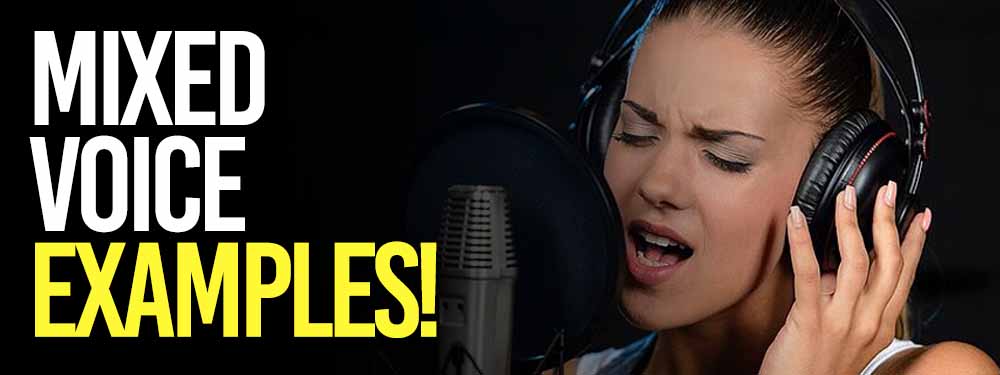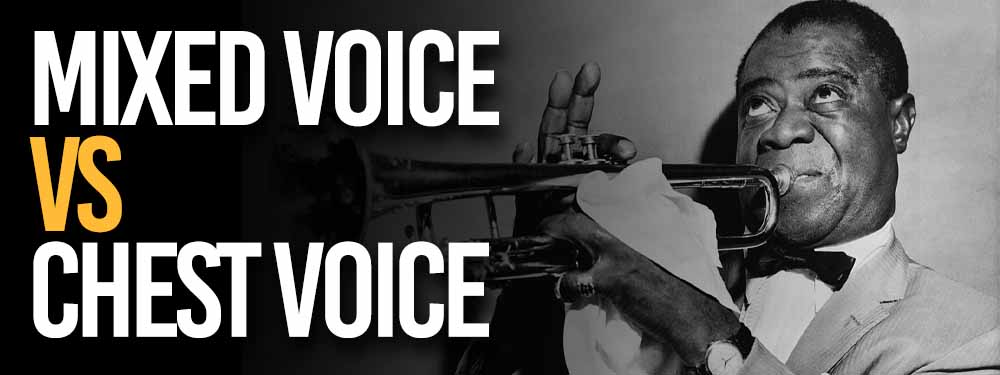
What is a mixed voice?
Do you know what mixed voice is?
A mixed voice is when you sing two or more different voice registers together to make a harmonic musical line. It's a combination of your chest voice and head voice.
Even though it may be hard at first to do, anybody can learn to sing in a mixed voice!
If you have trouble using your head voice or chest voice, then mixed voice singing is a great way to practice.
Chest and head voice is only one part of your true vocal range!
Mix voice singing is a large part as well.
A mixed voice can also be used to make harmonies on a track, like when two people sing together.
Listen to these singers use their mixed voices below. 👇
As you can see, using more than one voice when you sing adds a layer of depth to your storytelling.
Mix voice sounds great, and having a solid mixed voice technique will make you an amazing singer.
How should also learn How To Use Your Chest Voice for true growth potential!
Want to get your music on active & relevant playlists that actually get results?
Get your music heard now 👇
How to know if you're singing in a mixed voice
Many singers have trouble singing in ANY voice, let alone mixed voice.
If you have a hard time singing in general, mixed-voice singing won't be your main bullet.
An indication that you're using your mixed voice is that your chest and head voice are both activated. Both your lungs and throat are activated.
It takes a lot of practice to cultivate strong mixed voice sounds.
I don't want to discourage you from improving your mixed voice - it's just important that you understand what you're getting into.
But, hope is not all lost for your mixed voice!
This isn't a common skill that people learn, once your vocal folds get used to it.
Why do people singers struggle to use mixed voices?

Using a chest and a head voice comes naturally to most singers.
Why is the mixed voice so much more difficult?
You might have trouble with the mixed voice because you are using many skills at once.
Your vocal range has to manage two styles of singing (chest voice and head voice.)
Fortunately, can take steps to make it much easier.
It starts with breaking down your mixed voice into your head voice and chest voice.
Divide and conquer is an effective strategy for using your mixed voice.
Once you can fully express your chest and head voice, your mixed voice comes next.
Make sure you have a proper singer diet to protect your voice!
For example, a tenor who usually sings lower notes might have trouble getting a high note in their mixed voice...
In this case, you'll want to hit high notes every day.
This will accustom you to these higher notes, allowing you to sing higher and make a smooth transition into your mixed voice.
Here are some mixed voice examples.
Mixed voice songs (examples)

Mixing two or more voices in one song is tough, but you can easily find examples of it in popular music.
3 explains of a mixed-voice singing
- Dreams - Fleetwood Mac
- Everybody Wants To Rule The World - Tears For Fears
- Take Care - Drake & Rihanna
Rather than showing your chest voice or head voice, here's them both!
The mixed style of singing incorporates the mouth, chest, and head...
Listen to the tone carefully, and notice the open vowel.
Watch how these artists use their middle voices and push their vocal range far!
#1. Dreams - Fleetwood Mac
Christine McVie is the lead singer of Fleetwood Mac.
She has an excellent middle voice, able to hit both high notes and lower notes too.
Listen to the video below, and focus on her middle voice. 👇
They can mix different styles (head and chest) to create a consistent tone.
This tone is the one register that almost everyone can sing!
It's a combination of mouth techniques.
As Christine uses her middle voice, she does a smooth transition from her chest and head voice.
While she doesn't have a "deep voice" per se, it's a strong chest voice.
#2. Everybody Wants To Rule The World
Tears For Fear is one of my favorite bands!
As you listen, focus on the way the chest voice and head voice is used.
Listen for the mix-style voice in the video below. 👇
As a voice teacher would say, "It's not what you have, it's how you use it."
Hear the way the voice is a mix of different styles.
If you can mix your style like this... The mix can make you famous.
You can hear a mix of different medflies in this track.
#3. Take Care
This is a very interesting song.
Drake and Rihanna are both using their head and chest voices.
Even though Rihanna can hit low notes, she makes a seamless transition to the higher pitches.
This is especially apparent in the hook. 👇
One of the reasons these artists are so successful is their ability to sing higher notes as well as lower notes in succession.
Drake can only sign a few notes less than Rihanna but that's expected from male singers.
He's still able to express vocal breaks exceptionally.
How to find your mixed voice!

People call this "mixed voice." It's when you sing in two different voices at the same time.
By singing the melody in one part of your voice, and the lyrics in another part of your voice with less volume, you can do this.
A different way is to change the melody and words so that both voices are singing at the same time, but they're in different octaves or keys.
Think about it this way: It's not that hard to do even though it seems hard.
You need to figure out how to switch back and forth between two parts of your voice that are easy for you.
Use the right method as well.
3 best mixed voice exercises

Here are the best ways to improve your mixed voice sound!
5 was to train your mixed voice:
-
Abrupt switches
-
Take a long breathy vocal break
-
Clearing your throat
You'll be able to hit a new tone with your mixed voice, just follow along with these exercises to develop your voice!
#1. Abrupt switches
Female singers can access their chest voices much easier than males can hit higher pitches.
If you're a man reading this, here's a mixed voice practice for you:
Rather than making the transition from one part of your voice to another smooth, try to make it abrupt.
When you do this, you can see how the track changes and the listener can follow along.
#2. Long, breathy vocal breaks
Try taking a long break transition.
Normally, the transition is quick (less than a second) but practice breaks last multiple seconds.
What this break does is reinforce that muscle movement.
Once you can break it in, then you'll be able to manage that tone for longer.
#3. Clear your threat a lot
This is very easy to do but highly overlooked.
As a singer, your throat is everything to make a sound.
You should break in your mixed voice by clearing your throat a lot.
Try clearing at different tones, and not leave even one register uncleared.
After 2-3 minutes of clearing, you can take a short break.
What you'll notice is the clarity of voice you've never heard before!
Test different Mixed voice singing techniques
In the first place, figure out what's going on.
It's important to figure out which parts of your voice are most comfortable and then sing them while skipping over the parts that bother you.
If higher pitches come naturally to you, then your mixed voice can lean closer to your head voice.
On the flip side, if low notes are your strength then a chest voice style mixed voice works.
Once your style of mixed voice is established then you need to find an easy way to switch back and forth between the two parts of your voice.
How do your vocal cords work?
The vocal cord's main job is to protect two pairs of vocal folds from each other by covering them with a small piece of soft tissue.
They help us make noise.
When you make vocal sounds, your vocal folds open, and your vocal cords move, which makes the sound.
Since this soft tissue can be stretched and pushed back, you have control over your vocal range.
Seems simple?
It pretty much is.
The size and shape of the parts of your vocal cords can also change the sound you make.
When you get vocal damage, you lose the ability to make certain tones.
In this case, your vocal cords may become less flexible, which will change the sound that you make.
Once this happens, your ability to do a vocal break disappears... S there does your singing skills.
Each word or vowel sound that you say has a different length of time that your vocal cords need to be open and closed.
This explains why some words like "Horatio" are more difficult to say than "bin"
How can you train your voice?
Most of the time, the more you use a certain set of muscles, the easier it will be for them to stay where you want them to stay (assuming there is no vocal damage.)
As soon as you want to change the way your voice resonates, you need to relax the cords.
Going from chest register to head voice needs work and lots of TIME!
On the plus side, the rest makes your vocal folds less stressed.
Practicing your chest register and going one note at a time will improve your vocal break skills.
If you feel your mixed register isn't coming fast enough... Don't worry.
Over time long time, you'll learn how to keep your vocal cords relaxed when you sing to maintain the same tone of voice.
Singing higher notes requires vocal exercises but with the help of a vocal coach, you can speed up this process.
Men vs. Women vocal cords

When a man speaks, his voice feels different from that of a woman because of the way his vocal cords work.
Everyone has a vocal cord, but the length of the vocal cords is different between men and women. Due to the enlarged vocal folds, men have deeper, breathier voices.
There's a benefit to having a man's voice!
Male singers can use their chest voice with much more ease than women.
This makes the male voice sound strong and confident, since the longer your vocal cords, the deeper and fuller your voice will be.
On the flip side, women's voices are equally beautiful.
Had voice comes naturally to women, without even needing a vocal coach.
As a general rule, most women want a higher-pitched voice, or "women's length," to make them sound like they're more feminine.
That said, they can easily practice their chest voice and learn to hit low notes.
TLDR: take care of your vocal cords, regardless of gender because they help you speak, sing, and communicate with the rest of the world. You can't change your natural vocal range, but you can improve it over time.
female mixed voice range
Women's voices are more interesting than men's, and that's a fact.
Women have different timbres and tones, which is why it's also the case, too.
Other than that, a woman's voice has an irresistible sweetness to it.
There have been many singers and songwriters who have been able to make good use of this.
This doesn't mean that every woman has a lovely voice.
Learn how to improve your natural female voice so that it feels more real by reading this text.
They're some simple ideas.
They will help you improve your job as a singer and let people hear your singing.
This is what they will do. Learn why it's good to have a more powerful female voice in this part.
Mixed Voice compared to head & chest voice
There is a lot of misinformation about the difference between head voice and chest voice.
So what is the difference?
When we sing a high note, we can hear the sound echo in our heads. Then we can sing the same note again in a lower register and it comes from the voice. That's the difference.
A "head voice" and a "chest voice" are two different types of vocal sounds that people use.
There is a certain sound when you sing in a different register, and it's a sign that you're probably singing in a certain vocal register.
Having open vowels and chest push can develop your mixed voice nicely.
Don't forget: moving your vocal cords isn't the only thing you do when you sing in a different range!
This will improve your chest voice and head voice accordingly.
People who use their vocal folds also change how big and how long the air column that they make looks and sounds.
The chest, lips, and throat all must change for a good voice break.
Your mouth is the least important organ in a sense.
Good resonance only comes when a sound can transition from your chest to your mouth.
In many cases (such as falsetto) you focus on just the throat to hit loud high notes, and lips are less relevant.
Head voice vs mixed voice
It's only possible to sing with your head voice in a certain range and pitch where your chest is not activated much.
The higher vocal register is only open to a small number of people. Many singers never get to use it because it's so hard to use.
The transition from chest to head voice is less drastic if you have good throat control.
(Generally, falsetto is for women since their vocal cords are small and flexible.)
At some point between the third and fourth octaves, the head voice comes out.
Because this register is so high, it's very hard to get your hands on and very rare.
Make sure you develop your head voice in conjunction with the mix.
The head voice is essential and needs special attention.
Never neglect the head voice.
One of the other names that people use for head voice is "the lost register."
The head voice is very different from your mixed voice!
Chest voice vs mixed voice

How does the chest voice compare to the mixed voice?
Your "chest voice" when you sing with a lot of airflows. This activates the middle and upper chest and feels powerful.
People who speak in a chest voice can get deep into their chest cavities for the lower pitches.
In the chests, there is a lot of room for air, so they can get inside their bodies.
People with wide chests may have weak head and throat muscles, which means they can't get food into their mouths.
Should you always sing in mix voice?
There are no rules for how you use your mixed voice.
Try singing in many different voice registers and see how it works for you!
The best way to figure out which voice register is best for you is to try it out and see what happens.
Which one makes you feel more at home?
Which one is better to sing?
Sometimes the chest voice or head voice is the best option for you.
You can also try singing in the "wrong" register while you're trying new things.
This will help you open your vocal cords and get used to singing in different ways.
People who are having problems with their chest voice should pay attention to how frequently they sing in each voice.
If it's hard to push through your resistance and reach your chest cavity, then take things slowly.
Good resonance comes with time. After a certain point, you're bound to improve from small, consistent efforts.
No matter which register you choose, there is no right or wrong way to do it.
Every singer has a different shape and size of their body that allows her to speak in different ways.
Try different registers and see which one works best for you so you can give the best show possible!
Get your music on playlists now.
It’s time you get your exposure and listeners up - playlisting by Boost Collective has been trusted by 50,000+ artists worldwide.
It’s easy: Search your song, get on playlists, and track your campaign.
What’re you waiting for? Tap in - and get added to playlists in 24 hours.
Join Boost Collective for free here.


